Do all content writers write all their content from their own first-hand experience?
The simple answer is no.
What most content writers and content marketers do is rely on external sources to write their content; more known as curating content.
The sources that writers use to curate can be news, blog posts, published interviews, books, and more.
But there is a huge difference between content curation and plagiarism.
In this article, we’ll cover what curation truly is and how you can start doing it yourself.
Alright, let’s jump in!
Definition of Content Curation
Content curation is the process of finding, gathering, and presenting information on a specific topic in a new manner as a way of maximizing value to your target audience.
What Are the Benefits of Content Curation?
Increased Exposure, Reach, and Engagement
By sharing content from different sources, a content curator can connect with a wider audience and expose more people to their work and increase their engagement.
You can also build your backlinks by reaching out to those who inspired you with your curated content.
Content curation is especially useful for businesses or bloggers trying to establish themselves in new industries or topics.
Better Search Engine Visibility
Content curation enables you to add more layers to your content.
And the more comprehensive your content is, the more beneficial it is for your readers.
The more beneficial your content is, the more likely it is to be visible on search engine results pages (SERPs).
This can help drive more traffic to your website or blog, and ultimately increase exposure for your business.
Saving Time
Content curation allows you to quickly and easily access a wide range of information on a specific topic.
Rather than spending time and effort researching and developing your own content, you can simply aggregate content that has already been created by others.
This can be a great strategy for bloggers or businesses with limited time and resources.
Enhanced Credibility
By sharing high-quality content from trusted sources, a curator is seen as an expert in their field and can build a strong reputation within their community.
This can help to establish trust and credibility with readers, as well as improve your brand image and visibility.
How to Do Content Curation
Find Information
First, you want to research what others are saying about the topic you want to cover.
For example, if you want to curate content about growth hacking, search the term and take a look at what these articles are talking about.

You can also find information about your topic using SEO tools.
We’ve compiled a detailed step-by-step guide for you on how you can use SEO tools to come up with keywords that give you hyper-relevant results!2
Gathering Information
Once you start reading these, look for the answers to two simple questions:
- What do they have in common?
- What makes each article original?
The most frequent information is mostly the core of the topic. Make note of the most frequent headings so that you can cover them in your own words—of course, while adding your spin to them.
Next, look for gaps within articles. These gaps are what make each article provide different or more value.
Make note of what people are adding to the conversation in your list.
Here’s a quick application of how the process can look like:
| Common Information | Gaps |
| Growth hacking definition | List of books related to growth hacking |
| Who is a growth hacker | Visual of trends |
| Growth hacking vs marketing | Visual of growth hacker’s vs marketer’s funnel |
| Growth hacking examples | Process for growth experiments |
To learn more about how to identify gaps in topics, read our content gap analysis article.2
Presenting Information
Now that we’ve gathered information, you want to present the topic in your own way. This entails working on your:
- Order of ideas, i.e., choosing the order that resonates with the flow you want to create in your article.
- Depth and comprehensiveness, i.e., adding more layers to a specific section and tackling points that aren’t given much attention in other articles.
- Word choice and structures, i.e., writing your thoughts and ideas in your own words.
Pro Tip: Cite the sources that you quote or paraphrase ideas from.
Taking credit for somebody else’s work is considered plagiarism and you can get sued—let alone ruin your reputation.
And most importantly, make sure you add your own thoughts or analysis to whatever you cite.
Here’s a good example of how you can cite another article’s ideas from our article about Google Search Console:2

Types of Content Curation Tools
Aggregator Platforms
Also known as content discovery tools, these platforms gather different articles related to your topic of research.
Great content curation tools include:
- Feedly
- AllTop
- Google Alerts
Social Media Platforms
Social media has evolved over the years. Since businesses now use social media to share all kinds of information, you’ll find stellar ideas for content curation.
Useful social media platforms include:
- Twitter—especially its free service, TweetDeck. (We cover it in detail below.)
- Quora
How to Use Aggregator Platforms for Content Curation
Feedly
Feedly is a safe and secure platform to stay up-to-date with topics and trends you’re interested in.
It provides a central hub for all the news you want and is cloud-based, so you can access your account from multiple devices—computers, iOS, Android, and Kindle Fire.
Feedly is by far one of the best tools to use for content curation.
Why?
Because it gathers all the relevant news and posts related to certain industries and niches based on your interests.
Let’s say we want to curate content about artificial intelligence (AI), we will use Feedly to look for relevant content ideas.
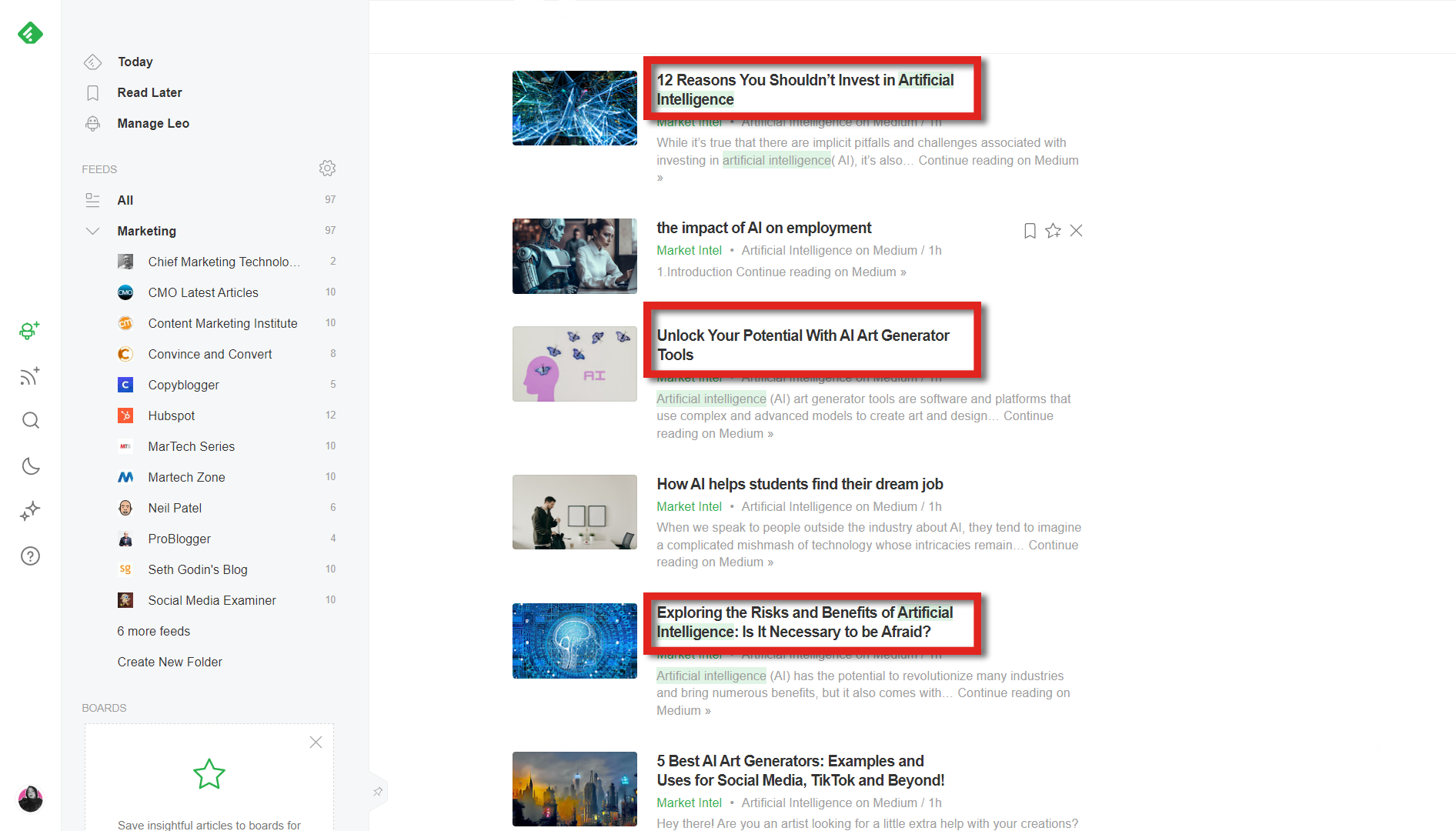
With just a simple search, we’ve come across three possible angles for how we can approach the topic:
- Why AI is NOT beneficial
- Why AI IS beneficial
- Why AI is BOTH, beneficial and risky
Next, you can read what people are talking about and start making notes to create curated yet original content.
AllTop
AllTop is an aggregator platform that compiles the top news and information from around the web in real-time.
To start with our research phase, we want a topic idea.
Let’s say we want to research topics related to eCommerce but we still don’t know where we can start.
Go to the “Menu” bar > Click on “Tech” > Choose “Ecommerce”.

Once you’re there, you’ll find resources that tackle different topic ideas related to eCommerce.
To clutter down your search even further, AllTop provides you with three categories:
- Popular Ecommerce Sites: Lists popular articles from popular eCommerce websites.
- Top Ecommerce Twitter Follows: Lists latest tweets of popular individuals in the eCommerce sphere.
- Best Ecommerce Sites for [year]: Briefs you on timely achievements that make its popular eCommerce sites featured on the platform and how you can benefit from them as a reader.
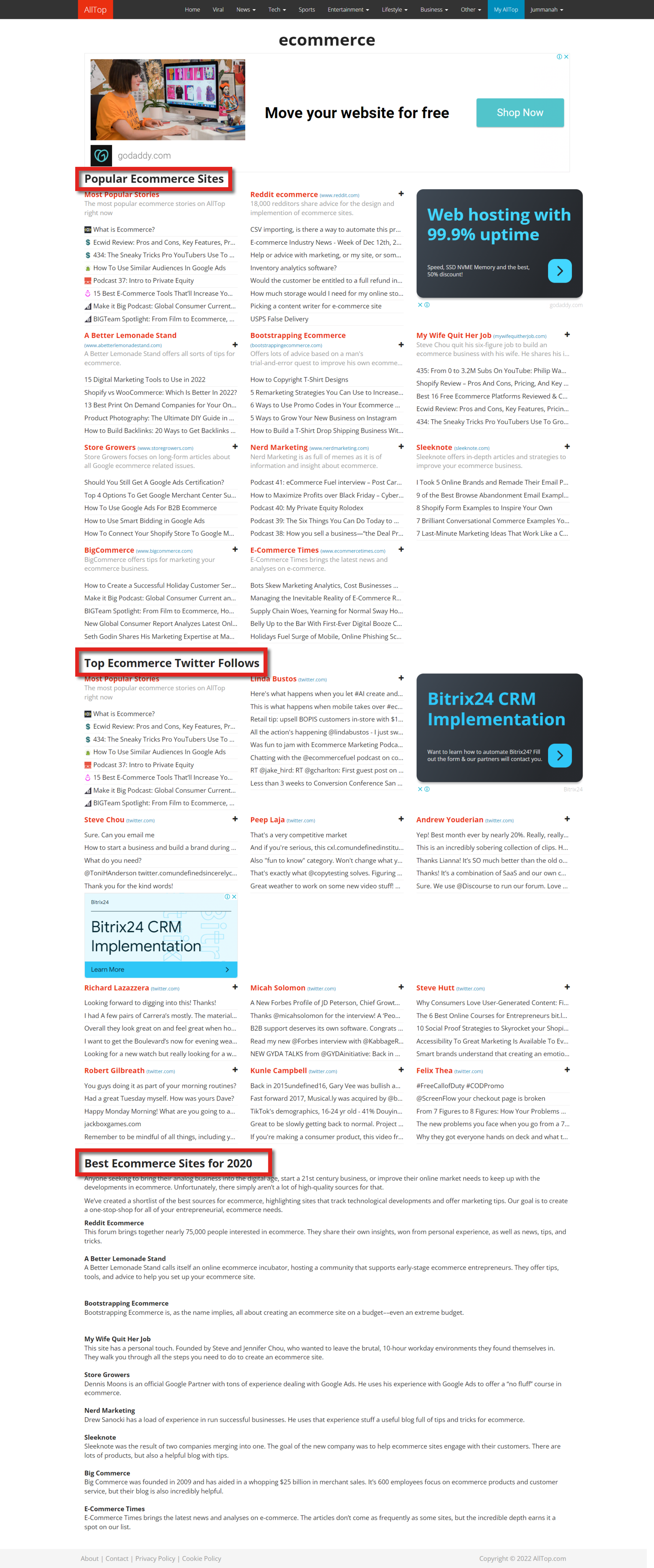
Now, let’s go to the “Popular Ecommerce Sites” section to look for fresh eCommerce-related topics to curate.
Looking through the “Reddit ecommerce” section, I can see an interesting topic idea: “Picking a content writer for e-commerce site”.

Someone is looking for answers about the essential skills of an eCommerce content writer.
From that person’s query, we know that a new angle we can take entails providing tips on how to prioritize eCommerce content writers based on a set of requirements that an eCommerce content writer should have.
We also now know that this person is one of the “eCommerce website owners”. Therefore, we can add this segmentation to our target audience.
So let’s see what others have to say about must-have eCommerce content writer skills using Google.
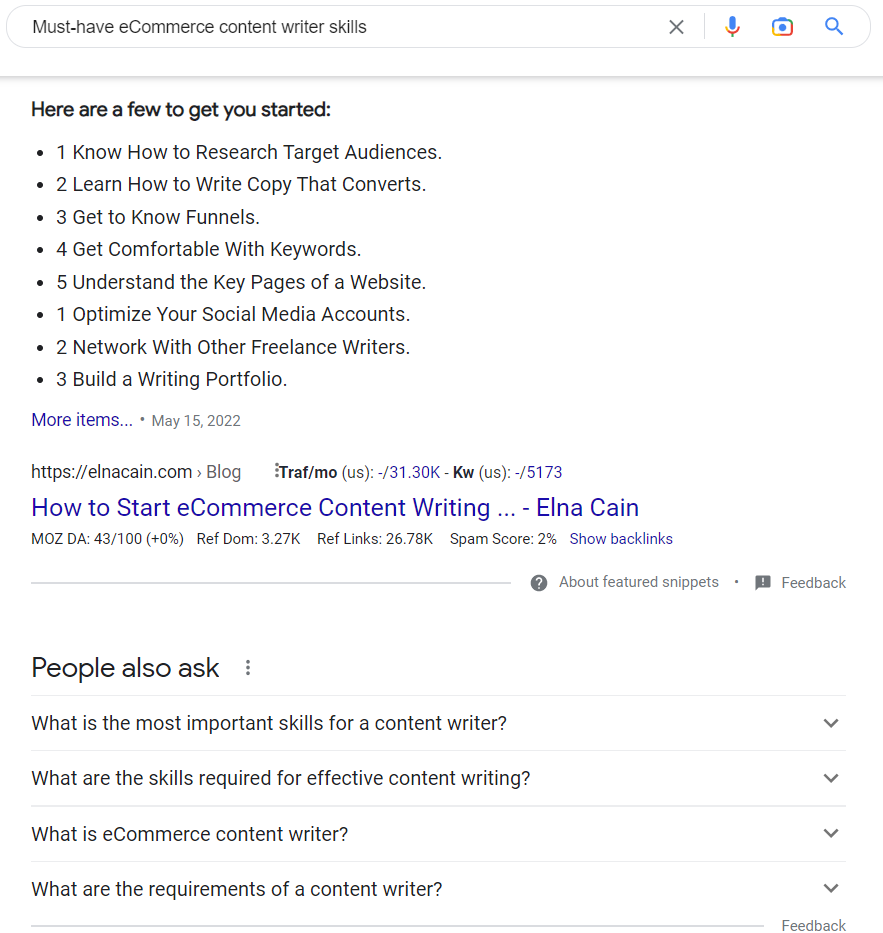
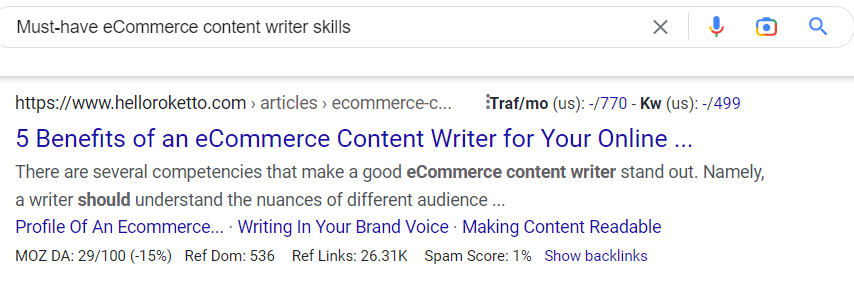
Judging from the headlines, we see that there are some conversations going on about the skills of an eCommerce content writer.
So we now know it’s possible for us to build on our competitors’ conversations to provide more in-depth tips about how recruiters can pick the most suitable candidate when they have more than one eCommerce content writer.
Google Alerts
Google Alerts is a free service from Google that helps users create alerts to stay updated on topics that matter to them.
“So what does this service have to do with curating content?”
You can use Google Alerts to type in keywords and keyphrases about topics that you want information about.
Once you set your alerts, you’ll start receiving emails with syndicated feeds about these topics.
To get hands-on experience on how you can use Google Alerts to curate content, let’s say you want to write an article about keyword research.
First things first, we’ll head to Google Alerts and then create an alert for “keyword research.”
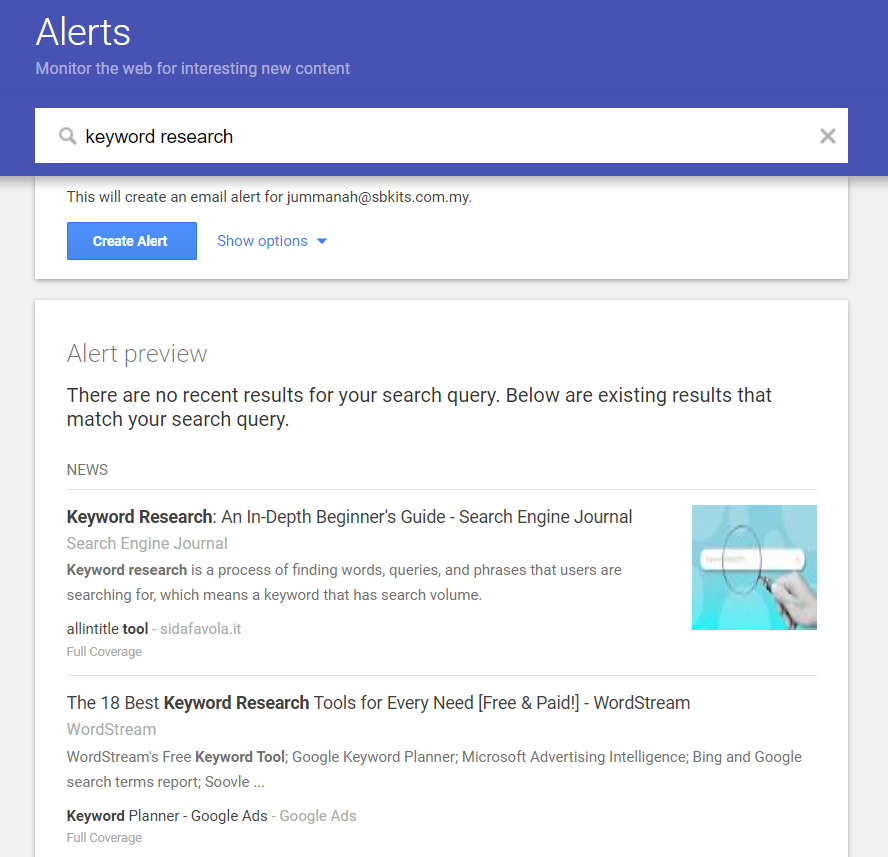
Click on “Create Alert” to start receiving alerts on your email about keyword research.
You can then read the results that Google Alerts has gathered for you to come up with your own content idea about researching keywords based on the most recent updates and information.
Pro Tip: You can use Google Alerts to get email alerts whenever Google releases a new update or whenever something related to its updates goes viral.
That way, you’ll stay ahead of the competition and become one of the very first businesses to educate readers about navigating through these updates!
Other interesting content curation platforms to consider are:
- Mention
- RSS.com
How to Use TweetDeck in Content Curation
In case you haven’t heard of it, TweetDeck is a free Twitter management service from Twitter.
It helps Twitter users manage their account(s) and see different feeds side by side in columns.
For example, you can view your notifications, messages, home feed, lists, and trending news/hashtags.
You can also add a column to view the results of a specific search.
“So how does that apply to content curation?”
TweetDeck makes it easier for you to use Twitter as a search engine.
Say you want to curate content about a topic in your industry.
You can filter your home feed in one column, view your lists in another, and search for relevant words or hashtags all from the same page.
Then, take a look at the results you see and compare them to come up with your unique content angle.
Make note of the tweets or media links that you can use as you curate and add your personal insights.
Content Curation and Content Creation: How Different Are They?
Content creation requires creativity and originality; they have to write their piece of content from scratch, relying on their experience and expertise.
With Content creation, you can either cite credible sources or conduct exclusive interviews with industry leaders to support your claims.
Content curation, however, relies heavily on finding existing content that fits into a specific theme or category.
Then, they present this information to readers while adding their own unique touch.
That unique touch can be:
- Adding extra depth or comprehensiveness to your subject matter.
- Providing simpler explanations of highly-complicated content.
- Adding your analysis to a roundup about a topic that is relevant to your readers.
Kickstarting Your Content Curation
Curating content is one of the best ways to go about your topic(s) when you’re looking for inspiration or want to provide your own insights about an existing topic.
With content curation, you’ll say goodbye to wasting time writing from scratch.
As a result, you’ll focus more on implementing other parts of your overall content strategy.
After all, what matters to you is to present information differently to your audience so that it becomes more digestible and relevant.
So what are waiting for?
Follow the steps above to share your original content with your people.
And if you need our help, we’re one click away!
Frequently Asked Questions (FAQs)
These tools allow you to easily discover, organize, and share fresh content with your audience in a way that is effective and easily digestible.
While plagiarism involves copying others’ work, content curation requires a significant amount of original thought and analysis.
When crafting curated content, a curator must carefully select which pieces of content to include in their collection, as well as how they will be presented.
Content curators should also include proper attribution to the original source.




